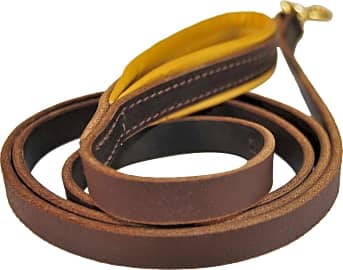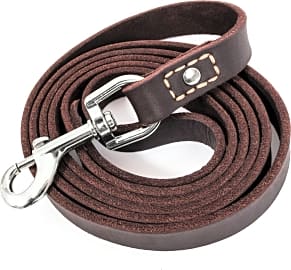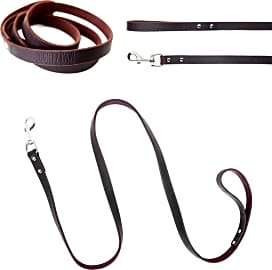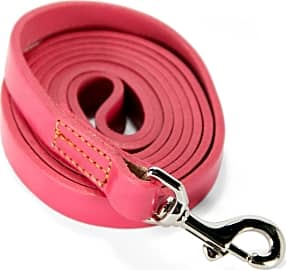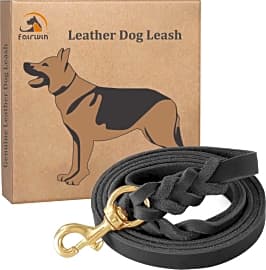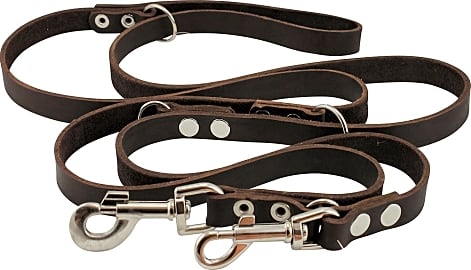The 10 Best Leather Dog Leashes

This wiki has been updated 41 times since it was first published in June of 2016. It's no secret that leather is one of the most durable materials around, so if you want a long-lasting tether to keep your energetic pooch under control when you're out together on a stroll, try one of these attractive and functional dog leashes. They come in a variety of sizes to accommodate all breeds, and in designs suitable for everything from rescue mutts to show dogs. When users buy our independently chosen editorial picks, we may earn commissions to help fund the Wiki.
Editor's Notes
February 27, 2019:
This list offers a range of width, length, and thickness options to meet the needs of owners of virtually any breed. For dog enthusiasts who are particularly concerned about style, we've included models that come in multiple colors, such as the Logical Leather Training. One of the most important aspects we considered while building this list was comfort — for both the pet and pet owner, which is why many of the products featured here have softened edges that are gentle against fur and skin.
Benefits Of A Leather Dog Leash
The great thing about leather is that it tends to soften over time, so it will actually feel better the longer you use it.
Listen, we're going to tell you something you probably already know: your dog will be judged on his style.
Do you honestly think that pretty golden retriever across the street will give him the time of day if he strolls up wearing a nylon leash? Or that the prissy little French poodle down the block will let a man wrapped up in chain sniff her tail?
And don't even get us started on retractable leashes — what are we, still in doggy daycare?
No, your dog needs something stylish, yet durable. Your dog needs a leather leash.
The main benefit of a leather leash is that it's extremely strong. If you have a larger breed, especially if he's a puller, you'll want something that you know won't snap in two at an inopportune moment. Leather leashes can last for years, regardless of how big (or enthusiastic) your pooch is.
Having your dog pull on you constantly can put a beating on your hands, leading to blisters, pinched fingers, and other injuries. The great thing about leather is that it tends to soften over time, so it will actually feel better the longer you use it.
That's not to say that leather models have no downsides, of course. They tend to be a little heavier than many other varieties, so your Chihuahua might feel like he's dragging an anchor behind him on his walk.
Also, they tend to be more expensive than their nylon counterparts. Not only that, but they usually don't have any bells and whistles, like reflective strips or adjustable lengths. You probably won't want to get it wet, either, so they're not ideal for use in inclement weather.
The biggest downside, though, is that your dog will likely chew through it if you leave it on the floor by accident — and then he'll blame you for not taking him for a walk. Put it out of his reach as soon as the walk's over.
Do the positives outweigh the negatives? That's up to you, and it depends on your particular situation, but it's highly unlikely that you'll regret buying a leather leash. They're classic, simple, and understated — just like ol' Rex over there.
Well, just like ol' Rex before you gave him the mohawk, that is.
Why Your Dog Needs To Be On A Leash
We know, we know — your dog is well-behaved. Your dog doesn't need to be on a leash. While we trust you, there's still good reason to keep your dog restrained every time you leave your home.
The biggest reason is that, in most places, it's the law. You can get a ticket if an officer sees your dog off-leash, and in some cases, your pooch may even be subject to being impounded.
Or if he has a strong prey drive, he might find a furry creature of his own to play with, like a squirrel or a cat.
Also, if something happens with your dog while he's not leashed, there's a good chance you'll be held liable — even if your dog wasn't at fault. This could mean anything from biting a kid who's harassing him to accidentally spooking an old lady and causing her to fall over.
That underscores the primary danger of not having your dog leashed. Just because you can trust him doesn't mean you can trust other dogs. Some animals react aggressively when confronted by another dog, even one who's well-behaved.
You also just don't know what might happen. A car could backfire, spooking your pooch and sending him scurrying into traffic. He could come face-to-face with a rattlesnake while out on a hike, and you won't be able to pull him back in time. Or if he has a strong prey drive, he might find a furry creature of his own to play with, like a squirrel or a cat.
Ultimately, keeping your dog on a leash is a small price to pay for the safety and peace of mind that it affords you. It's not worth taking any risks with the life of your best friend, and most importantly, having him on leash makes it much easier to walk up hills.
Teaching Your Dog To Walk Calmly While Leashed
One of the biggest reasons why people abandon their leashes (well, their dog's leash...you know what we mean) is because their pet is ill-mannered whenever that restraint goes on. If that sounds familiar, here are some steps you can take to nip that bad behavior in the bud.
Expect it to take some time to train him properly. Be patient and consistent with your feedback as well, and use plenty of positive reinforcement — and that means cookies.
It also provides you with a safe space if things go haywire.
A good way to make the whole thing go as smoothly as possible is to tucker your dog out before every training session. Take him to the park, play fetch — whatever you have to do to burn off that excess energy.
Start by practicing inside. This is helpful, as everything in your home should be familiar to Fido, so there's less incentive to get to the next exciting smell as quickly as possible. It also provides you with a safe space if things go haywire.
Everything else depends on his specific issues. If he starts pulling, immediately stop and don't let him go any further until he returns to you.
If he lunges at other people or animals, you'll need to redirect his attention to you before danger strikes. Just know that this is something that takes quite a bit of time to resolve, and until you do, it's best not to walk him when others are around.
If all else fails, consult a trainer. There's a lot happening on every walk that you might not be aware of, and a trustworthy trainer can help spot and troubleshoot any issues.
Also, you can probably convince the trainer to walk your dog for you. After all, you're paying him.




